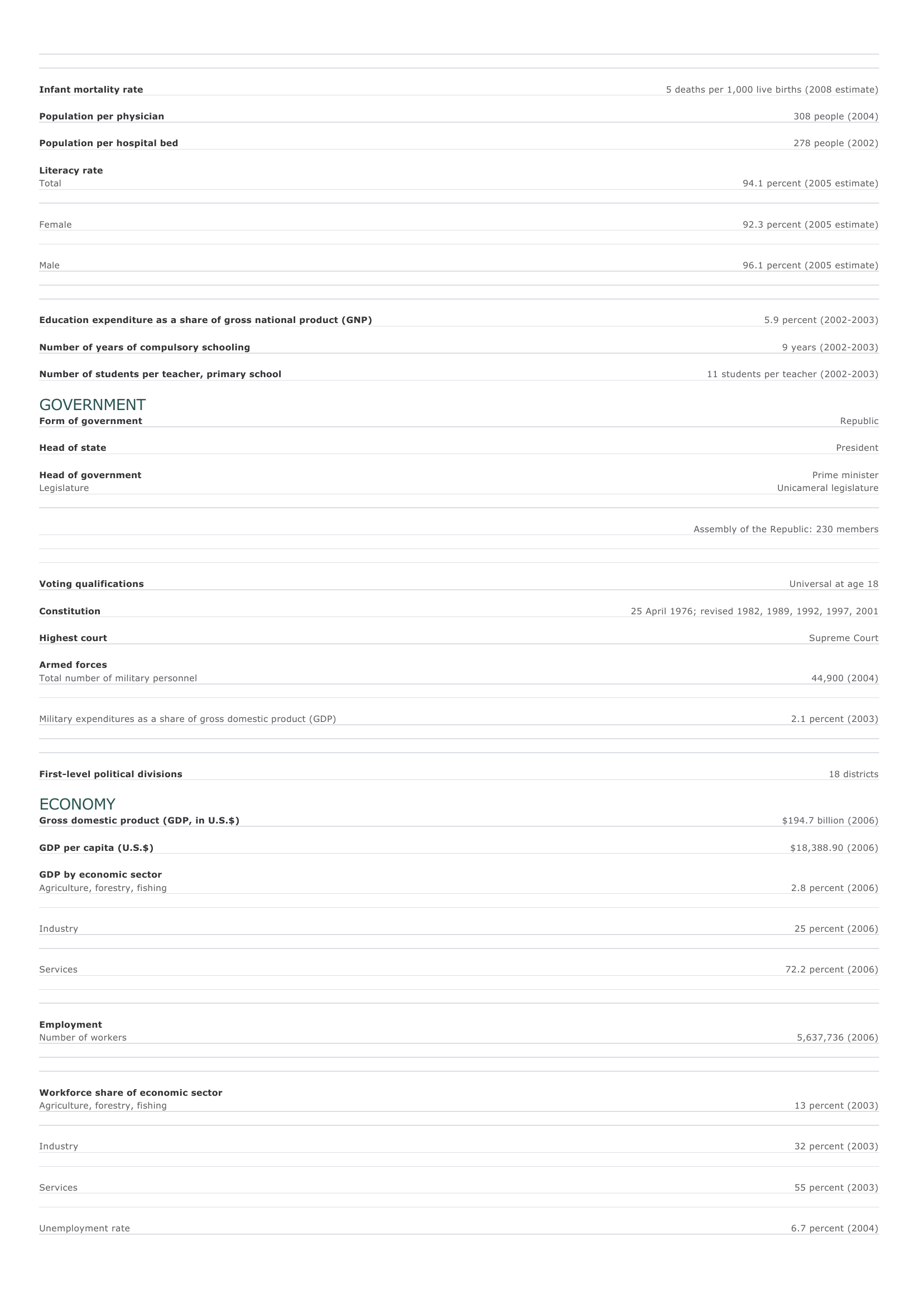
Portugal Facts and Figures. BASIC FACTS Official name Capital Area Portuguese Republic Lisbon 92,345 sq km 35,655 sq mi PEOPLE Population 10,676,910 (2008 estimate) Population growth Population growth rate 0.30 percent (2008 estimate) Projected population in 2025 10,806,202 (2025 estimate) Projected population in 2050 9,933,334 (2050 estimate) Population density 116 persons per sq km (2008 estimate) 301 persons per sq mi (2008 estimate) Urban/rural distribution Share urban 56 percent (2005 estimate) Share rural 44 percent (2005 estimate) Largest cities, with population Lisbon 1,962,000 (2003 estimate) Vila Nova de Gaia 288,749 (2001) Porto 263,131 (2001) Amadora 175,872 (2001) Ethnic groups Ethnically homogeneous; some black Africans Languages Portuguese (official), English, French, German Religious affiliations Roman Catholic 91 percent Protestant 1 percent Atheist 1 percent Nonreligious 5 percent O ther 2 percent HEALTH AND EDUCATION Life expectancy Total 78 years (2008 estimate) Female 81.5 years (2008 estimate) Male 74.8 years (2008 estimate) Infant mortality rate 5 deaths per 1,000 live births (2008 estimate) Population per physician 308 people (2004) Population per hospital bed 278 people (2002) Literacy rate Total 94.1 percent (2005 estimate) Female 92.3 percent (2005 estimate) Male 96.1 percent (2005 estimate) Education expenditure as a share of gross national product (GNP) Number of years of compulsory schooling Number of students per teacher, primary school 5.9 percent (2002-2003) 9 years (2002-2003) 11 students per teacher (2002-2003) GOVERNMENT Form of government Head of state Head of government Legislature Republic President Prime minister Unicameral legislature Assembly of the Republic: 230 members Voting qualifications Constitution Universal at age 18 25 April 1976; revised 1982, 1989, 1992, 1997, 2001 Highest court Supreme Court Armed forces Total number of military personnel 44,900 (2004) Military expenditures as a share of gross domestic product (GDP) First-level political divisions 2.1 percent (2003) 18 districts ECONOMY Gross domestic product (GDP, in U.S.$) $194.7 billion (2006) GDP per capita (U.S.$) $18,388.90 (2006) GDP by economic sector Agriculture, forestry, fishing 2.8 percent (2006) I ndustry 25 percent (2006) Services 72.2 percent (2006) Employment Number of workers 5,637,736 (2006) Workforce share of economic sector Agriculture, forestry, fishing 13 percent (2003) I ndustry 32 percent (2003) Services 55 percent (2003) Unemployment rate 6.7 percent (2004) National budget (U.S.$) Total revenue $75,112 million (2006) Total expenditure $82,403 million (2006) Monetary unit* 1 euro (EUR), consisting of 100 cents *The Portuguese escudo (Esc) became linked to the EU single currency, the euro (EUR), on 1 January 1999 at a fixed rate of 200.482 to 1 euro (EUR). Euro coins and bills replaced the Portuguese escudo as the national currency on January 1, 2002. Major trade partners for exports Germany, Spain, France, United Kingdom, and United States Major trade partners for imports Spain, Germany, France, Italy, and United Kingdom ENERGY, COMMUNICATIONS, AND TRANSPORTATION Electricity production Electricity from thermal sources 59.86 percent (2003 estimate) Electricity from hydroelectric sources 35.07 percent (2003 estimate) Electricity from nuclear sources Electricity from geothermal, solar, and wind sources 0 percent (2003 estimate) 5.07 percent (2003 estimate) Number of radios per 1,000 people 306 (1997) Number of telephones per 1,000 people 401 (2005) Number of televisions per 1,000 people 638 (2000 estimate) Number of Internet hosts per 10,000 people Daily newspaper circulation per 1,000 people Number of motor vehicles per 1,000 people Paved road as a share of total roads 220 (2003) 32 (1997) 463 (2001) 86 percent (1999) SOURCES Basic Facts and People sections Area data are from the statistical bureaus of individual countries. Population, population growth rate, and population projections are from the United States Census Bureau, International Programs Center, International Data Base (IDB) (www.census.gov). Urban and rural population data are from the Food and Agriculture Organization (FAO) of the United Nations (UN), FAOSTAT database (www.fao.org). Largest cities population data and political divisions data are from the statistical bureaus of individual countries. Ethnic divisions and religion data are largely from the latest Central Intelligence Agency (CIA) World Factbook and from various country censuses and reports. Language data are largely from the Ethnologue, Languages of the World, Summer Institute of Linguistics International (www.sil.org). Health and Education section Life expectancy and infant mortality data are from the United States Census Bureau, International Programs Center, International database (IDB) (www.census.gov). Population per physician and population per hospital bed data are from the World Health Organization (WHO) (www.who.int). Education data are from the United Nations Educational, Scientific and Cultural Organization (UNESCO) database (www.unesco.org). Government section Government, independence, legislature, constitution, highest court, and voting qualifications data are largely from various government Web sites, the latest Europa World Yearbook, and the latest Central Intelligence Agency (CIA) World Factbook. The armed forces data is from Military Balance. Economy section Gross domestic product (GDP), GDP per capita, GDP by economic sectors, employment, and national budget data are from the World Bank database (www.worldbank.org). Monetary unit, agriculture, mining, manufacturing, exports, imports, and major trade partner information is from the statistical bureaus of individual countries, latest Europa World Yearbook, and various United Nations and International Monetary Fund (IMF) publications. Energy, Communication, and Transportation section Electricity information is from the Energy Information Administration (EIA) database (www.eia.doe.gov). Radio, telephone, television, and newspaper information is from the United Nations Educational, Scientific and Cultural Organization (UNESCO) database (www.unesco.org). Internet hosts, motor vehicles, and road data are from the World Bank database (www.worldbank.org). Note Figures may not total 100 percent due to rounding. Microsoft ® Encarta ® 2009. © 1993-2008 Microsoft Corporation. All rights reserved. Microsoft ® Encarta ® 2009. © 1993-2008 Microsoft Corporation. All rights reserved.














